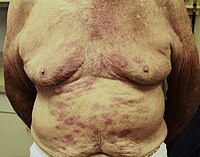
Photo from wikipedia
OBJECTIVE Our primary objective is to re-visit the tuberculosis and leprosy cross-immunity. hypothesis through the careful integration of immunology and paleopathology. METHODS Using an integrated theoretical analysis that evaluates clinical… Click to show full abstract
OBJECTIVE Our primary objective is to re-visit the tuberculosis and leprosy cross-immunity. hypothesis through the careful integration of immunology and paleopathology. METHODS Using an integrated theoretical analysis that evaluates clinical literature on human innate immunological responses, paleomicrobiology, bioarchaeology, and paleopathology, we develop a multifactorial model. RESULTS Past populations do not represent homogeneous immunological landscapes, and therefore it is likely that leprosy in Medieval Europe did not uniformly decline due to cross-immunity. CONCLUSIONS We recommend that bioarchaeological reconstructions of past disease experience take into consideration models that include variation in immune function based on past environments and social contexts. This provides a unique opportunity to conduct comprehensive analyses on complex immunological processes. SIGNIFICANCE Extrapolating results from experimental immunology to larger populations elucidates complexities of disease cross-immunity and highlights the importance of synthesizing archaeological, social, paleopathological and biological data as a means of understanding disease in the past. LIMITATIONS All extrapolations from data produced from in vitro studies to past populations, using living donors, pose significant limitations where, among other factors, the full reconstruction of past environmental and social contexts can frequently be sparse or incomplete. SUGGESTIONS FOR FUTURE RESEARCH To reduce the limitations of integrating experimental immunology with bioarchaeological reconstructions (i.e. how to use skeletal samples to reconstruct inflammatory phenotypes), we propose that osteoimmunology, or the study of the interplay between immune cells and bone cells, should be considered a vital discipline and perhaps the foundation for the expansion of paleoimmunology.
Journal Title: International journal of paleopathology
Year Published: 2019
Link to full text (if available)
Share on Social Media: Sign Up to like & get
recommendations!